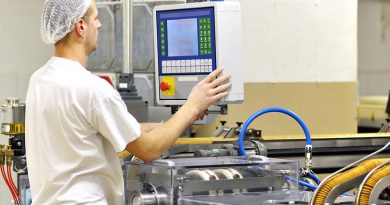Making digital transformation more than a concept
Digital transformation has become a goal for many businesses in the industrial sector, as automation technologies develop and the fields of information technology (IT) and operational technology (OT) converge. However, digital transformation is also an ambiguous concept to strive towards without a clear strategy. Here, we speak with Richard Kenedi, senior vice president of manufacturing at industrial software provider GE Digital, and George Walker, managing director of industrial automation expert Novotek UK, about the ideal path to industrial digital transformation.

GE was one of the first to make serious investments in digital technology and was arguably the first digital industrial provider. What are the key lessons learned from the GE that you would share with other industrial companies?
Richard Kenedi (RK): “The first is focus. You have to know your customers and how you can best help them. It’s not about the technology, it’s about solving the problem. I think secondly, it’s about attitude. We’ve learned that customers aren’t looking for a hero to save them, they want a guide to help them solve a problem today and see around the corners for tomorrow.
“Thirdly, it’s critical to have deep domain expertise when it comes to the people, processes and technologies of each industry we serve.
“In every industry, there are organisations that are implementing at the edge of technology and others that are slower in adoption. Each organisation is at its own individual point of digital transformation maturity. Issues range from culture to investment to workforce. Digital transformation is critical but planning and implementation can’t slow ongoing production. Each company needs guidance to approach digital transformation in a way that meets their holistic situation and requirements.”

Novotek UK & Ireland
For Novotek, as a GE partner in the UK and Northern Europe, you’ve been helping businesses digitalise and increase automation in their operations for some time. What are some of the common challenges when starting that process?
George Walker (GW): “As with any early stage technology, a lot of people initially struggle to separate the hype from the practical reality. Digital transformation, Industry 4.0 and digitalisation have becoming industry buzzwords in the past few years, with a lot of companies promising the Earth if a company installs its latest widget. Often we find companies want to digitally transform, but don’t have a clear picture of why or what they’re looking to achieve.
“The reality is all these concepts are a means to an end — they shouldn’t be the goal in themselves. The end goal might be improved productivity, higher throughput, reduced downtime or lower operating expenditure. Digital transformation is the vehicle that gets industrial businesses to that destination, and the systems that are required as part of that depend on the company’s specific outcomes, focusses and current operations.”
The biggest disadvantage of IT providers trying to fit corporate software into industrial settings is that although IT and OT are closely interlinked and complementary, they are still fundamentally different
George walker, novotek uk & Ireland
Often, IT providers claim their offerings can digitalise the manufacturing space. What is the difference between an IT and OT setting and why do you see a need for purpose-made software in the manufacturing space?
RK: “IT and OT have come a long way in convergence. In many cases, we’ve evolved from the boundaries and barriers of the past to greater collaboration. IT has gained respect for the real-time needs and process domain expertise of OT. OT has gained an appreciation for IT’s capabilities such as security and mobility. The people and the systems have to work together.
“Purpose-made software has been important for decades. Build-your-own solution is costly, and now more than ever, with our aging workforce retiring, the knowledgebase that continued to drive and support do-it-yourself solutions is becoming unavailable. Most organisations understand the risk that they’re taking on by considering do-it-yourself today.
“In contrast, purpose-made, out-of-the-box software provides a long-term solution with on-going innovation, maintenance, and support. Companies benefit from focussed development and best practices. For example, these out-of-the-box solutions help industrial companies support the reality of an operator’s job on the ground all the way to the plant manager, and even for global operations directors. You need to understand the failure modes and the success modes for their processes, and you need to understand how that translates into different KPIs across the organisation – for example, how OEE impacts revenue, or even new technologies.”
GW: “From our side, the biggest disadvantage of IT providers trying to fit corporate software into industrial settings is that although IT and OT are closely interlinked and complementary, they are still fundamentally different. These clear distinctions, between the environments in which they are used, mean that companies with comprehensive experience of serving industrial markets will always be better equipped to meet the needs of manufacturing software.
“GE, for example, is uniquely positioned due to its extensive history in the industrial space, as well as in digital technologies and software. Similarly, Novotek has worked closely with industry for many years and have developed modules and systems in response to industry issues and opportunities. This means we can both ensure that our software is built around the needs, wants and requirements of industrial environments, rather than being retroactively reshaped to meet a market brief.”

How does GE see itself differentiating itself from its competitors?
RK: “We are more focused on our target markets and industries, because these are the places where we believe we can best help our customers win. In those areas, it’s really about simplicity, speed and scale. Simplicity – because we’re investing across all our product lines to make it easier than ever for customers to adopt and adapt our technologies for their needs. That goes for user experience in the field, through to no-code rapid application development visualisation tools like Proficy Operations Hub.
“Speed – because really customers want return on investment as quickly as possible, and they want responsiveness if they have a problem, and scale – because with our technologies, teams and our partners we are able to bring solutions to customers not only for one line or factory but for an entire enterprise globally. When we bring simplicity, speed and scale together for customers, that’s when you see truly transformative results.”
What are the ideal first steps an industrial business can take towards digitally transforming their operations?
GW: “The first step should always be to plan and identify what you want to achieve. For example, if your focus is on innovating to develop better products and find new ways of operating, this might lead you towards systems such as a modern manufacturing execution system (MES). The MES, alongside SCADA systems on the plant floor, allows for automated feeds of data through each level of an industrial business and insight into all processes.
“Likewise, a business who wants to reduce the frequency of maintenance or downtime might opt for a Historian software that simplifies the collection, aggregation and analysis of data from equipment and operations. A specialist can advise the best systems to ensure the right results, if the business knows what its objectives are.
“This isn’t a decision to be made by one group within a company either. It’s important everyone, from the maintenance engineers to C-suite personnel, are involved in determining what the focus is to ensure buy in at every level. That way, you increase the likelihood that systems are introduced and set up to provide the insight each level of user needs, in the most effective way.”

